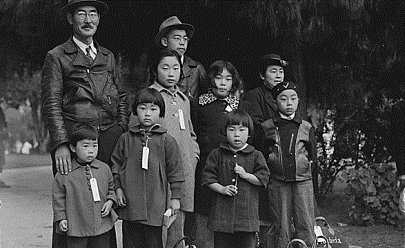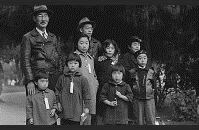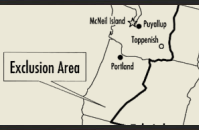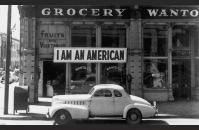JAPANESE-AMERICAN INTERNMENT AT A GLANCE:

Image Gallery
Japanese-American Internment: Executive Order 9066
On December 7, 1941, Japanese naval and air forces attacked the United States at Pearl Harbor, Hawaii, bringing the U.S. into World War II. In the weeks following the attack, fear and suspicion grew of the sizable Japanese American community in the U.S. Might these immigrants and first generation Americans side with Japan against the United States? Based on those fears, combined with a long history of anti-Japanese immigrant sentiment, the U.S. government forced more than 110,000 Japanese Americans living along the West Coast into Internment Camps for the duration of the war. In a war that the U.S. fought to preserve liberty around the world, this event stands out starkly as a violation of the civil and human rights of tens of thousands right here at home.
On February 19, 1942, President Franklin Roosevelt signed Executive Order 9066—an order that gave the War Department the authority to declare any part of the country a restricted military area “from which any or all persons may be excluded.” California, Oregon, Washington, and southern Arizona were soon designated as such. The persons to be excluded were Japanese Americans.
Beginning in March of 1942, Japanese Americans were ordered to register with the War Relocation Authority (WRA) for “evacuation.” Families were told they could only bring what they could carry. Businesses, homes, and possessions had to be sold or entrusted to neighbors or friends. Pets had to be left behind. Of the more than 110,000 people sent to Internment Camps, two-thirds were Nisei—first generation Americans—and the other third were Issei—born in Japan. A great many of the internees were children and teenagers.
By October 1942 nearly all internees were housed in ten hastily built camps run by the WRA. These camps were located in isolated, often desolate locations. Barbed wire and military police surrounded them. Along with loss of freedom, families shared a single room (often without plumbing and little heat), ate in communal dining halls, endured harsh weather, and suffered mental and physical stresses of being confined against their will. Nutrition, education, and health care were all inadequate. Despite these sub-standard conditions, people did their best to make life in the camps as “normal” as possible. They established schools and governing bodies, organized baseball teams, created music and art groups, planted vegetable gardens, and held religious services—anything they could do to make life in the camps bearable.
In 1943 the U.S. government reversed its exclusion of Japanese Americans from the draft (they had been considered enemy aliens) and asked for volunteers from the camps to serve in the military. More than 800 men volunteered and became part of the 442nd Infantry Regimental Combat team. The 442nd, which fought in Italy, Southern France, and Germany, became one of the most highly decorated units of WWII. While these men fought for America, their families were living behind barbed wire in their own country.
In challenging the constitutionality of Executive Order 9066, Fred Korematsu argued that his rights and those of other Americans of Japanese descent had been violated. In Korematsu v. United States, the Supreme Court ruled 6-3 in favor of the government, saying that military necessity overruled those civil rights. In his dissent, however, Justice Frank Murphy stated that the exclusion of Japanese Americans “falls into the ugly abyss of racism.”
Executive Order 9066 was finally rescinded on January 2, 1945, and internees slowly began to return home to rebuild their lives. In 1988 the U.S. government issued a formal apology to all former internees and paid $20,000 to each surviving internee. The government acknowledged that the internment had been based on “race prejudice, war hysteria, and a failure of political leadership.” To this day, Japanese American Internment during WWII is studied as a cautionary tale of the need for vigilance when maintaining the constitutional rights of all Americans.
Download a printable version of this At A Glance
TAKE ACTION:


EDUCATION PROJECTS:
Student Travel – WWII Educational Tours
High school and college students, learn the leadership principles that helped win WWII on a trip to France or during a weeklong residential program in New Orleans. College credit is available, and space is limited.
See You Next Year! HS Yearbooks from WWII
Collected from across the United States, the words and pictures of these yearbooks present a new opportunity to experience the many challenges, setbacks and triumphs of the war through the eyes of America’s youth.
The Victory Gardens of WWII
Visit the Classroom Victory Garden Project website to learn about food production during WWII, find lesson plans and activities for elementary students, get tips for starting your own garden and try out simple Victory Garden recipes!
The Science and Technology of WWII
Visit our new interactive website to learn about wartime technical and scientific advances that forever changed our world. Incorporates STEM principles to use in the classroom.
Kids Corner: Fun and Games!
Make your own propaganda posters, test your memory, solve puzzles and more! Learn about World War II and have fun at the same time.






